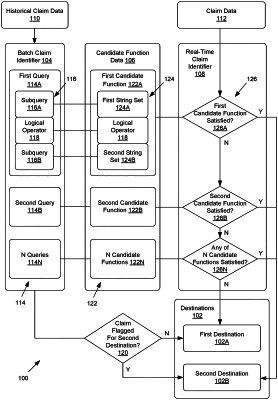| CPC G06Q 10/063112 (2013.01) [G06F 16/3329 (2019.01); G06F 16/35 (2019.01); G06Q 40/08 (2013.01)] | 17 Claims |

|
1. A method, comprising:
generating, by a batch claim identifier of a claim identification system, a first string set and a second string set by executing, on instances of a historical claim data, a language processing query expressed using a syntax of a computer-readable language to identify:
first text strings, of the first string set, that satisfy a first subquery of the language processing query, the language processing query being further configured to identify insurance claims that are to be assigned to a particular destination, and
second text strings, of the second string set, that satisfy a second subquery of the language processing query;
obtaining, by the claim identification system, claim data associated with an insurance claim;
identifying, by the claim identification system, a candidate function associated with the particular destination for the insurance claim, wherein the candidate function comprises:
the first string set comprising the first text strings that have been identified as satisfying the first subquery of the language processing query;
the second string set comprising the second text strings that have been identified as satisfying the second subquery of the language processing query; and
at least one logical operator that relates the first string set and the second string set;
determining, by the claim identification system, that the claim data satisfies the candidate function by determining, without executing the language processing query, that one or more text strings in at least one of the first string set and the second string set are present within the claim data in a pattern corresponding to the at least one logical operator; and
assigning, by the claim identification system, the insurance claim to the particular destination, based on determining that the claim data satisfies the candidate function.
|